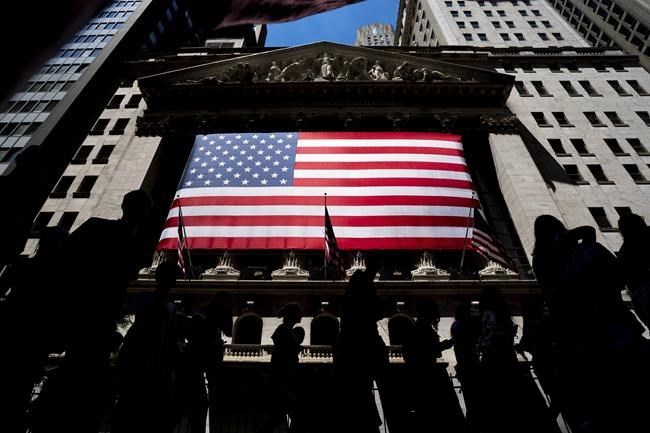NEW YORK (AP) — Wall Street closed out its longest weekly winning streak in six years after big gains earlier in the week on hopes for lower interest rates in the U.S. The S&P 500 ended an up-and-down day little changed Friday. It still posted a solid gain for the week and its seventh straight weekly gain. The Dow added 0.2%, reaching its third all-time high in a row. The Nasdaq composite rose 0.4%. Hopes for cuts to interest rates from the Federal Reserve in 2024 have sent Treasury yields tumbling this week, which releases pressure on the stock market.
THIS IS A BREAKING NEWS UPDATE. AP’s earlier story follows below.
NEW YORK (AP) — Wall Street is hanging around its record highs on Friday and on track to close out its longest weekly winning streak in six years.
The S&P 500 fell 0.2% and is within 1.7% of its all-time high set early last year. It’s heading for a seventh straight winning week.
The Dow Jones Industrial Average, which tracks a smaller slice of the U.S. stock market, was down 46 points, or 0.1%, a day after setting a record for the second straight time. The Nasdaq composite was 0.2% higher, as of 2:46 p.m. Eastern time.
The company behind Olive Garden, Ruth’s Chris Steak House and other restaurant chains fell 0.2% despite reporting stronger profit for the latest quarter than analysts expected. Darden Restaurants gave a forecast for revenue for its full fiscal year that fell short of analysts’ forecasts.
A 4.4% gain for Costco helped offset that weakness. It rose after reporting stronger results for the latest quarter than analysts expected and saying it will send $6.7 billion in cash to its shareholders through a special $15 dividend.
Stocks overall have bolted higher this week after the Federal Reserve seemingly gave a nod toward the hopes that have sent Wall Street screaming higher since autumn. Fed Chair Jerome Powell at a press conference on Wednesday did not forcefully push back on traders’ expectations that inflation has cooled enough for the central bank to not only halt its market-hurting hikes to interest rates but to consider cutting rates.
The S&P 500 has jumped roughly 15% since late October on rising hopes for just such a shift. Lower rates not only give a boost to prices for all kinds of investments, they also relax the pressure on the economy and the financial system.
Hopes for several cuts to rates from the Fed in 2024 have sent Treasury yields tumbling in the bond market, which in turn releases pressure on the stock market.
The 10-year yield stabilized a bit on Friday. It rose to 3.94% from 3.92% late Thursday. It was above 5% in October and at its highest since 2007.
With inflation down from its peak, Bank of America is forecasting 152 rate cuts from central banks around the world in 2024. That would be the first year since 2020 that cuts have outpaced hikes.
Of course, some more cautious investors say markets have gotten ahead of themselves in their ebullience. The big moves seem to be predicated on the Federal Reserve pulling off what was considered a nearly impossible task not long ago.
The Fed’s goal has been to slow the economy and grind down prices for investments enough through high interest rates to get high inflation under control. It then has to loosen the brakes at the exact right time. If it waits too long, the economy could fall into a painful recession. If it moves too early, inflation could reaccelerate and add misery for everyone.
That’s a lot of ifs. Plus, many critics say the number of rate cuts that traders are expecting in 2024 doesn’t seem likely unless the U.S. economy falls into a recession.
With the huge rallies so far, “markets all-in on infallible Fed,” strategist Michael Hartnett wrote in a BofA Global Research report.
Those rallies may also be threatening the very futures investors are banking on. Lower Treasury yields and higher stock prices can encourage businesses and households to spend more, which keeps the economy strong but can add upward pressure on inflation.
A preliminary report on Friday indicated growth for U.S. business activity may be ticking higher. It cited “looser financial conditions,” which is another way of describing movements that could encourage businesses and people to spend more.
“Looser financial conditions have helped boost demand, business activity and employment in the service sector, and have also helped lift future output expectations higher,” said Chris Williamson, chief business economist at S&P Global Market Intelligence.
Williamson also said a measure of pressure on inflation “remains sticky but at a level which is indicative of” inflation at the consumer level running only modestly above 2%. The Fed's goal is to keep inflation at roughly 2% while maximizing the job market.
In stock markets abroad, Hong Kong’s Hang Seng index jumped 2.4%, with stocks of property developers rising after some Chinese cities eased buying restrictions. The Hong Kong market has been one of the world’s worst this year on worries about property developers and the overall health of the Chinese economy.
Most other markets around the world have been strong in 2023 amid hopes for cooling inflation and anticipation for cuts to interest rates.
___
AP Business Writer Elaine Kurtenbach contributed.
Stan Choe, The Associated Press



